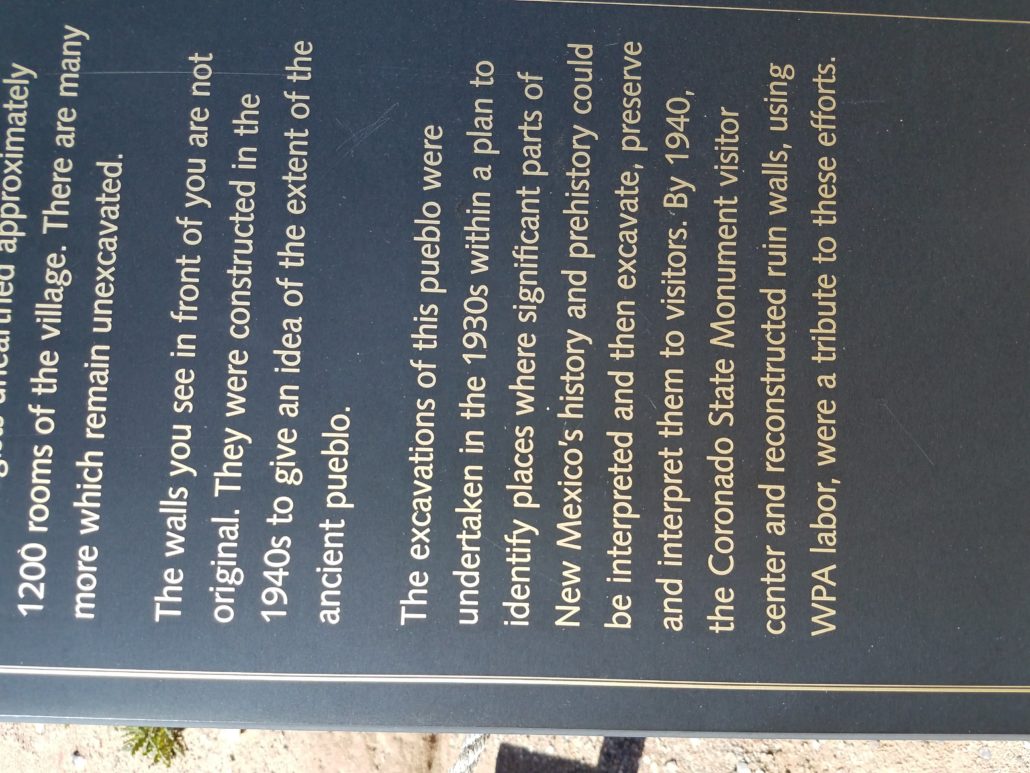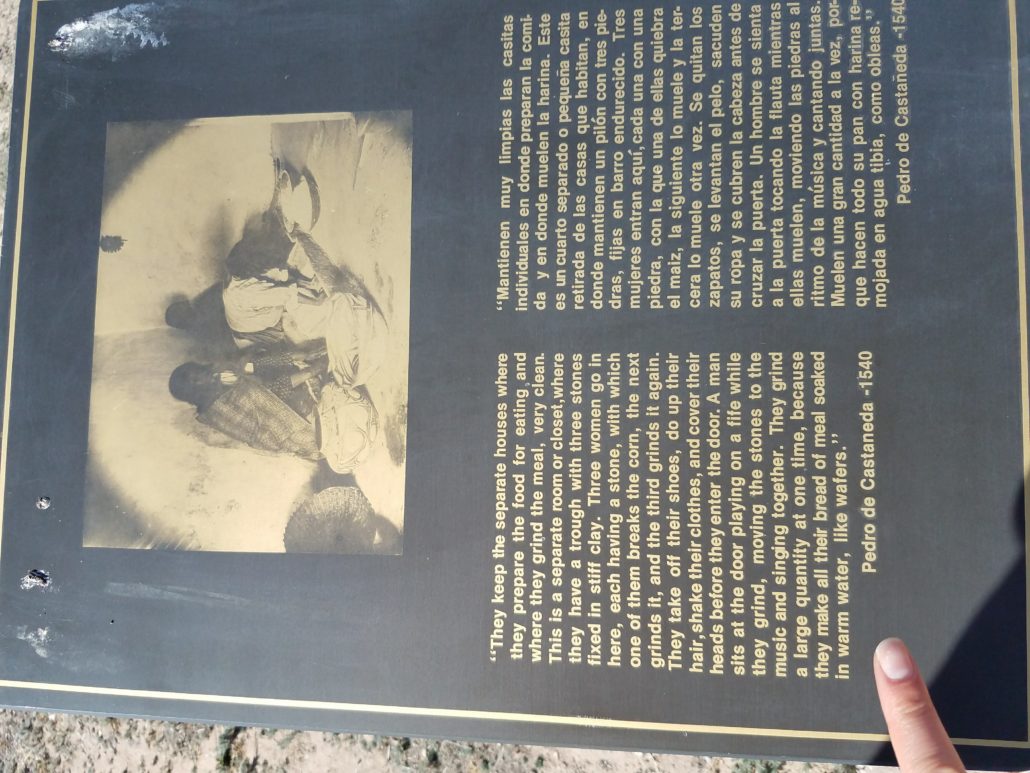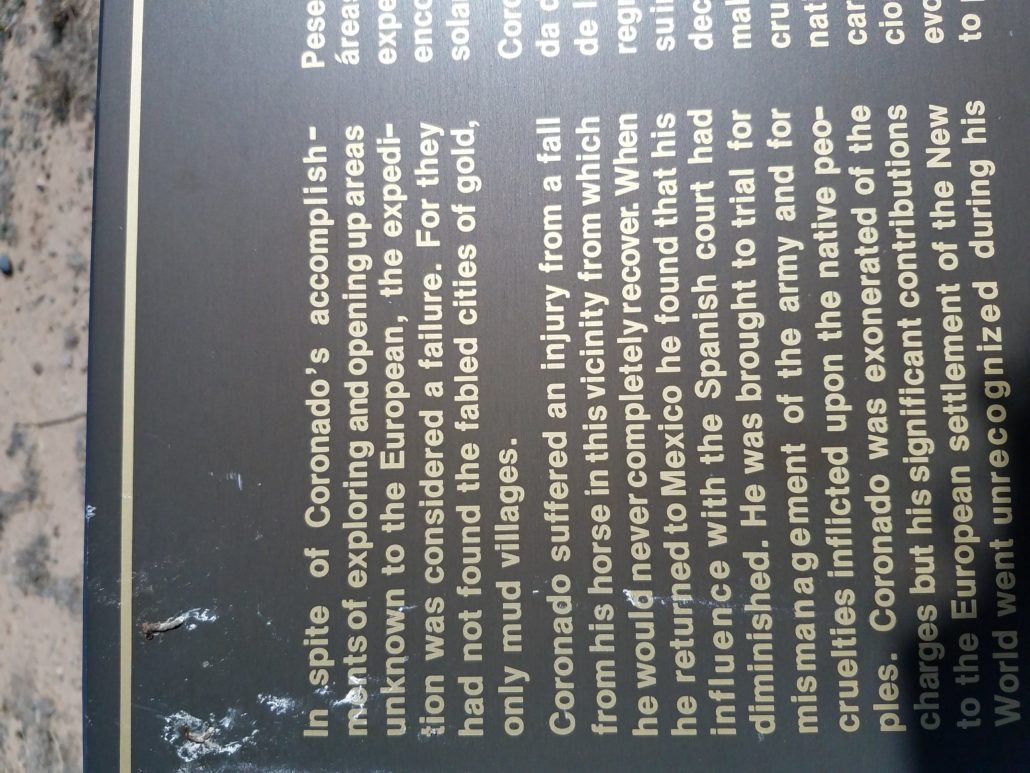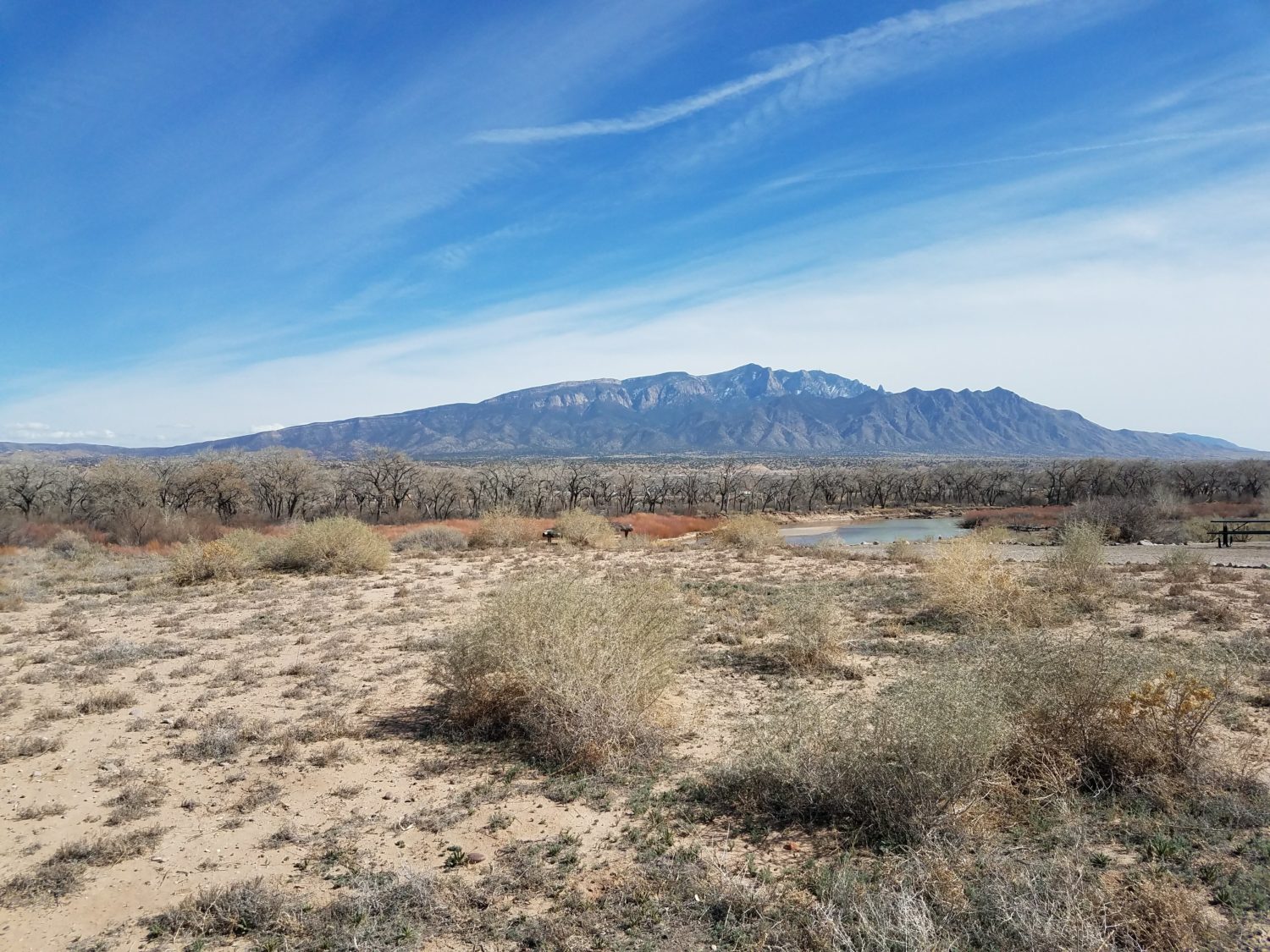I loaded up my dog in the car and drove over to my friend’s house to pick her up. My friend is a New Mexican native, and she was so excited to go with me. She’d never been to the Coronado Historic Site, despite living so close to it for many years.
We talked about our contrasting in experiences with Southwestern history. Growing up, she took so many classes in New Mexican History that it surprises her I knew nothing. I kept trying to explain how the majority of history books leave out information and lie about what happened–how bias our textbooks are.
“This is the BEST way to learn New Mexican history” she kept telling me, and we discussed our expectations of the historic site.
We knew the Coronado Historic Site was going to be messy–the name alone promotes a bias about whos history the location represents. We were armed only with the description from the Department of Cultural Affairs:
In 1540, Francisco Vásquez de Coronado—with 500 soldiers and 2,000 Indian allies from New Spain—entered the Rio Grande valley somewhere near this site. Coronado was searching for the fabled Seven Cities of Gold. Instead of treasure, he found a dozen villages inhabited by prosperous native farmers. These newly “discovered” people spoke Tiwa, and their ancestors had already been living in this area for thousands of years. Coronado called them: Los Indios de los Pueblos or Pueblo Indians. He and his men visited all twelve Tiwa villages during the course of the next two years because they survived on food and other supplies that they obtained from them. Without the assistance of the Tiwas (willing or unwilling), Coronado and his men very likely would have starved to death.
Already we were talking about how the site focused on Coronado and erased the history of the people that lived there for hundreds of years before Spanish contact. However, we never would have imagined just how much eraser we would see.
The first plaque as you enter the historic site tells a lot about the motivation for designating the historic site:

We could not get past the phrase “Interpreted to visitors” because it seemed like such a contrast to the other words in the sentence. That rather than discovering and learning from the sites–an action that places visitors in direct contact with historical artifacts, the site was purposely created to add a third party between the two–someone who could present a particular angle of history. The interpreter selects what he or she finds most interesting to present to a tourist. Or worse, he or she selects the story they’d like the tourist to experience and engage with.
This is the same sentiment I saw on the Department of Cultural Affairs website, where history is driven by tourism more than an understanding of events. But Coronado site is worse than that; It’s false advertising.
Misinterpreting
We went to the state Historic Site looking for artifacts from Coronado. In reality, they have no evidence that the Spanish ever had encounters with the natives at this prehistoric village (and thank goodness). The Coronado historic site, in reality, has nothing to do with Coronado–or even the conquistadors. It’s a prehistoric indigenous village that bears the name Coronado because that’s what the interpreters wanted visitors to experience–the invasion of a village very different from their own culture.
According to our tour guide, in the late 1930s archeologists went looking for the village where Coronado passed the winter. Diaries explain that Coronado and his troops would not have survived the winter without the help of indigenous natives, and so they passed the winter together in a native pueblo before Coronado slaughtered them. In anticipation of the 200 year anniversary of Spanish Conquest in North America, archeologists wanted to find identify a place where SPANISH history collided with New Mexican collided with prehistory. Where the location could be interpreted, excavated, and interpreted for the purpose of tourism.
None of the structures at the Coronado Historic Site are original to the prehistoric ruins once found there. Not original, nor accurate. Archeologist found the remains of a village. However, the remains seemed too fragile to preserve. Therefore, shortly after excavating it, they buried it again and built up replicas. Our tour guide noted that they technics the WPA workers built in the late 30’s were not similar to those used by the original inhabitants, and even some of the structures are not to scale. However, there are no signs indicating the inaccuracies.
Misappropriating
The Coronado Historic Site was meant to uncover information about Coronado’s “accomplishments of exploring and opening up areas unknown to the European.” When they did not find the artifacts to do so, they appropriated the pueblo–not just culturally, but physically and geographically. Tourists could “get an idea” of what it might be like to come across these villages as the Spanish conquistadors once did.
We see this in the plaques describing the site to contemporary visitors. They invite us to “imagine many small agricultural fields” during the peak of its time. Some descriptions are very prosey with images of the children playing with chickens in the plazas. But it’s important to understand that the sight does not invite you to experience the village from a native perspective.
In fact, the contradictory plaques sometimes acknowledge the structures are replicas and other times suggest they are prehistoric: “The pit-like structures to your left and right are the ruins of underground chambers called kivas”

Another disturbing fault of the placards throughout the historic site is that they are from the perspective of the Spanish people despite that there is no evidence to suggest the Spanish made contact with this village. They use Spanish words, like estufa, to describe objects that do not culturally exist in Hispanic culture and history. Furthermore, the descriptions are othering in their language. They’re even offensive.

In this example, De Castañedo constantly maintains a sense of “they,” without acknowledgment of any similarities. He is surprised to find that the tribe he describes (obviously not the tribe that lived here) is hygienic in dealing with their food. We see in his language that he perceives the native as primitive and he praises their level of civility and domesticity.
Furthermore, the plaque descriptions are celebratory of conquering and neutral toward Spanish violence. In the same sentence, we read:

You cannot take a location in time or space that represents domination and unchecked power and cruelty and remain neutral in blame. It does not accurately portray historical events. The only thing unrecognized here is how the whole historical site devalues the people that actually lived here. A native village misappropriated to Celebrate Spanish conquest and violence and covered up under the guise of tourism.
Everything about this State Historic Monument, from its name to the interpretation was already established for a particular occasion–the anniversary of Coronado coming to New Mexico–with a particular goal in mind–creating a sense of pride for the “discovery” and domination of the cultures that lived here before. Sadly, the motive that keeps all this running is a fake nostalgia, a desire to live an experience that never happened. It’s an experience that maintains the ignorance about history I learned. Worse, it invites “New” Mexicans to remain apathetic toward natives and celebratory of the violence against them.
Misleading
When I spoke to New Mexico Historic Site Instructional Coordinator, Ethan Ortega, on the phone, he made an off-hand comment that really stuck with me. He returned my call wanting clarification on what I meant when I asked about historic monument sites. A few years ago New Mexico changed the official name of the designation–State Historic Sites became State Historic Monuments. As a result, more people come to the sites looking for statues or something more resembling our collective understanding of monuments. It’s a smart rhetorical play on language to bring in revenue. The misleading and ambiguous language creates a misconception that works in favor of generating interest and revenue.
Unfortunately, that is also what we see in the Coronado State Historic Monument. Nothing is real. The name is misleading, the structures are replicas, the descriptions are biased and misappropriated. And somehow this site retains its merit as a historical interpretation for visitors. It’s clear to me how this site got its designation: capital and coercion.

Just saw this entry from a week ago as email went to my spam folder….Interesting.
That means you subscribe to my updates. I need to write more on this, but I have gotten caught up on other work.